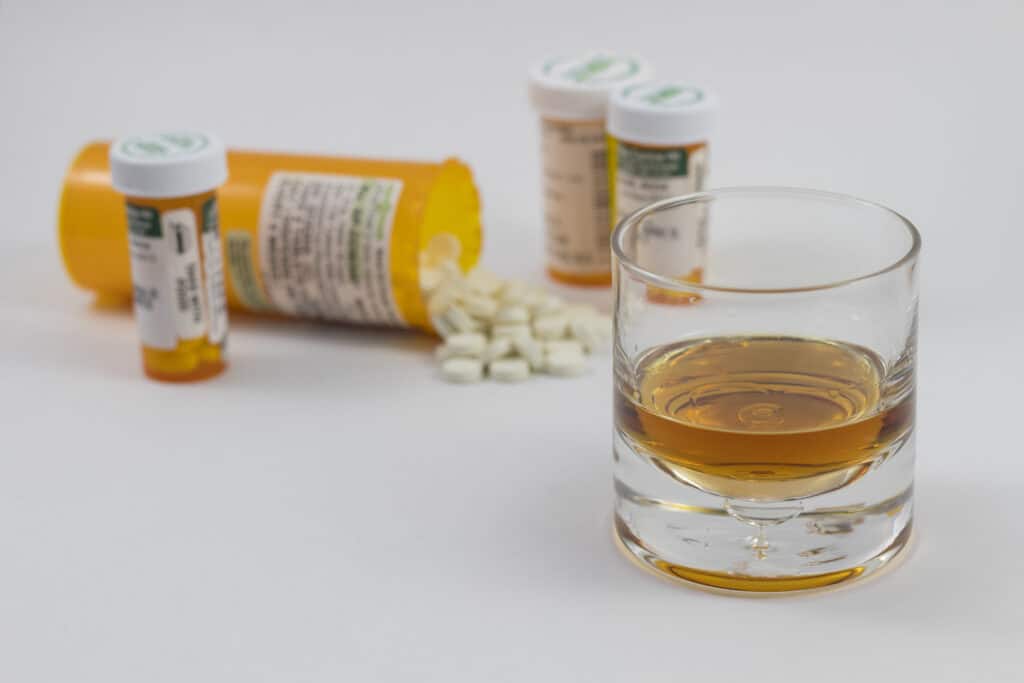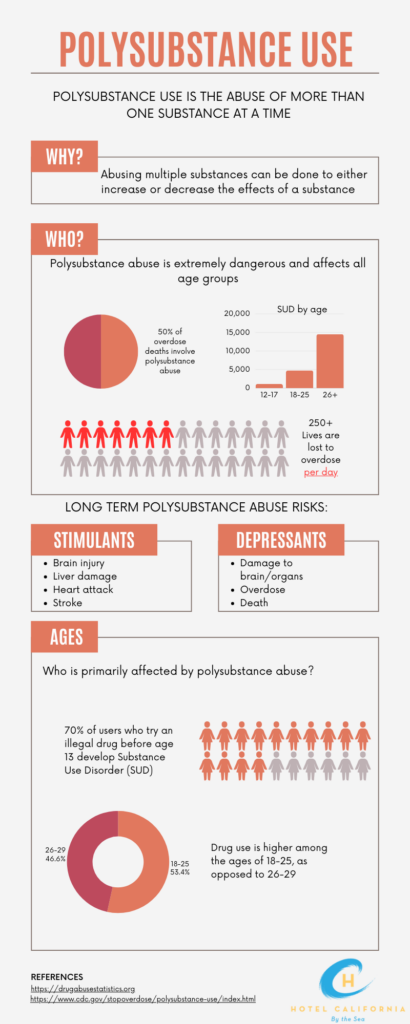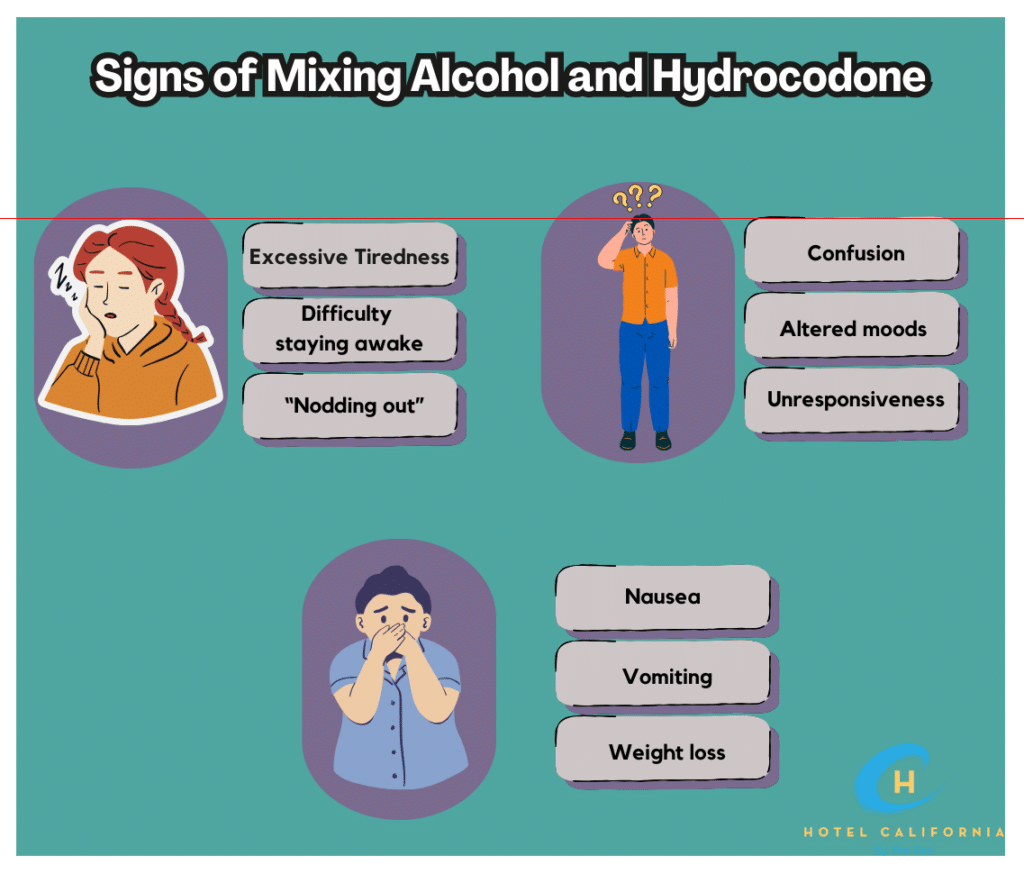Polysubstance Use: Hydrocodone and Alcohol
Polysubstance use is not an uncommon occurrence. Those who engage in polysubstance use often have an addiction to one or both substances. This is especially true when it comes to using substances with alcohol. Alcohol is a central nervous system depressant and when used with other drugs, can enhance or intensify their effects. One common polydrug pairing is hydrocodone and alcohol. Hydrocodone is an opioid drug commonly prescribed to relieve moderate to severe pain. Mixing hydrocodone and alcohol can lead to potentially dangerous effects with short and long-term consequences.

What is Hydrocodone?
Hydrocodone is a semi-synthetic opioid usually under the brand name Vicodin. Vicodin’s main active ingredients are hydrocodone and acetaminophen. It is commonly prescribed for post-surgery pain, relief for chronic pain and to help with the discomforts of chronic coughing. The drug works by binding with the opioid receptors in the brain. Mu opioid receptors are responsible for feelings of positive reinforcement, euphoria and intense relaxation.
In 2014, an estimated 120 million hydrocodone prescriptions were written out to patients. Hydrocodone is a Schedule II Controlled Substance and the second most popular opioid prescription medication. In 2015, an estimated 12.5 million Americans used hydrocodone and of those, 2 million were addicted to the prescription painkiller. Other brand names of hydrocodone include Norco and Lortab. These medications are also composed of a combination of hydrocodone and acetaminophen.
With repeated use of hydrocodone, the brain produces feel-good sensations and encourages drug-craving behaviors and habits, leading to continued use of the drug. The opioid reactions in the frontal cortex of the brain can also become weaker over time. This leads to the users losing the capacity to control their own decision-making and mood-regulating abilities naturally. Another factor in abuse and addiction occurs when a user is taking the drug over a long period of time and because of their reliance, they find it becomes difficult for their brain and body to naturally produce feelings of euphoria.

Effects of Hydrocodone misuse:
- Blurry vision
- Confusion
- Euphoria
- Lightheadedness
- Nausea
- Rapid breathing
- Slowed heartbeat
- Seizures
- Sleepiness
- Slurred speech
- Insomnia
- Liver damage
- Kidney damage
- Depression and anxiety
The prescription painkiller is normally safe when taken as prescribed by a medical physician. However, like other opioids, there is a potential for dependence and addiction. An opioid prescription addiction usually involves taking more pills than prescribed. It can mean continuing to take pills beyond the prescribed time frame. And it can mean taking pills in other ways other than how they were intended to be taken.

Hydrocodone and Alcohol
Mixing hydrocodone and alcohol can lead to very dangerous effects. Both alcohol and hydrocodone have very similar qualities and both affect the central nervous system. They are sedative drugs that slow down brain activity and can produce brain fog and intense sedative effects.
When taken together, they can produce severe cognitive impairment and extreme fatigue. Euphoria, sedation and relaxation from both substances can occur more quickly, be more intense and last over a longer period of time when hydrocodone and alcohol are taken together. Alcohol causes the sedative effects of opioids to intensify and can create a faster intoxication state compared to drinking alcohol alone. One of the biggest dangers of polydrug abuse is a dangerously low heart rate, respiratory depression and risk of overdose.
Side Effects of mixing Hydrocodone and Alcohol
- Abnormal behaviors and mood swings
- Dizziness
- Impaired cognition and judgment – decreased thought production, illogically thinking, inability to form new memories, disinhibition
- Loss of coordination and decreased reaction time
- Extreme fluxion in blood pressure
- Suppressed heart rate
- Shallow breathing, difficulty breathing – respiratory depression
- Dehydration
- Nausea and vomiting
- Fatigue, sleepiness and sedation
- Coma
- Extreme euphoria
- Reduction in various autonomic nervous system
- Liver damage
- Kidney damage
- Damage to the cardiovascular system
- Increased risk of infection
- Increased risk of developing a substance use disorder
In a 2017 study, research found that between 15-20% of people who died of opioid-related causes were also found to be drinking alcohol. So why are so many people using a combination of drugs? Studies have found that people who binge drink are more likely to misuse prescription opioids like hydrocodone. Some people who mix hydrocodone and alcohol, do so on purpose to produce a greater sense of euphoria. Other people mix the drugs because they are already suffering from an addiction to one or both substances.
Check Your Insurance Coverage for FREE
Find out if your insurance covers addiction treatment in minutes. We accept most insurance!
Dangerous Consequences caused by polysubstance drug abuse of Hydrocodone and Alcohol
According to the Centers for Disease Control and Prevention, it is never safe to take opioids such as hydrocodone, with alcohol. Even if the alcohol levels are at a minimum. Opioid and alcohol polydrug combinations significantly increase the risk of respiratory depression and overdose. The risk of overdose is the most life-threatening symptom of the two substances combined.
Symptoms of overdose from Hydrocodone and Alcohol
- Loss of consciousness
- Extreme shallow breathing
- Limp body
- Cold and clammy skin – the appearance of the skin is pale or flushed
- Extremely erratic pulse
- Choking and vomiting
- Decreased cognitive functions
- Excessive dizziness
- Extreme confusion
- Irregular heart rate
- Nausea
- Seizure
- Respiratory depression
Alcohol is metabolized in the liver. When there is an excess of alcohol being consumed, the liver works double time in order to keep up with the consumption. Hydrocodone medications such as Vicodin contain acetaminophen. Excess amounts of acetaminophen can also impact the liver. It can lead to acute liver failure either by taking a single dose that is too high or doses that are too high over several days. The strain of both substances overloading the liver can cause significant damage to the organ with continued abuse of hydrocodone and alcohol.
Signs that someone you know may be abusing both Hydrocodone and Alcohol
- The person can become extremely intoxicated given the amount of alcohol that was ingested.
- The person exhibits signs of using alcohol while on hydrocodone.
- The person experiences withdrawal symptoms when they are without either substance.
- The person takes more hydrocodone than is initially prescribed.
- The person takes hydrocodone more often than initially prescribed.
- The person who was prescribed hydrocodone drinks regularly.
- The person visits multiple doctors in order to get more prescriptions for hydrocodone.
- The person becomes socially withdrawn from friends and families.
- The person begins to neglect personal and professional responsibilities.
Reach out to Hotel California by the Sea
We specialize in treating addiction and other co-occurring disorders, such as PTSD. Our Admissions specialists are available to walk you through the best options for treating your addiction.
Treatment for Polysubstance Abuse
Abusing multiple substances such as prescription opioids and alcohol can be dangerous and life-threatening. The compounding effects of both can cause significant effects on the brain, cardiovascular system and liver. Not only will it cause physical damage, but it can also begin to affect daily aspects of life including, work, school, personal relationships and responsibilities. Overcoming and addiction to one or more substances is not easy. The support and resources from a professional behavioral health treatment program such as Hotel California by the Sea can help clients achieve the best outcome.
Our treatment center provides a specialized prescription painkiller treatment recovery program as well as an alcohol use disorder treatment program. Hotel California by the Sea provides all levels of care including detox, residential treatment programs, partial hospitalization programs and intensive outpatient programs. Throughout each level of care, clients will also receive one-on-one counseling as well as group therapy sessions. Such treatment methods include CBT, DBT and EMDR therapy.
At Hotel California by the Sea, we believe each client has their own unique needs when it comes to recovery and treatment. By addressing varying aspects of addiction including physical and psychological, we will be able to provide the tools and resources for a successful recovery.
References:
https://www.addictioncenter.com/opiates/hydrocodone-addiction/vicodin/
https://vertavahealth.com/blog/the-dangers-of-mixing-alcohol-with-hydrocodone-vicodin/
https://sdtreatmentcenter.com/alcoholism/vicodin-alcohol/
https://www.chapmanrehab.com/post/dangers-of-mixing-hydrocodone-with-alcohol
https://www.niaaa.nih.gov/health-professionals-communities/core-resource-on-alcohol/alcohol-medication-interactions-potentially-dangerous-mixes
https://www.goodrx.com/well-being/substance-use/opiates-and-alcohol
https://www.addictioncenter.com/alcohol/alcohol-oxycodone/
https://www.deadiversion.usdoj.gov/drug_chem_info/hydrocodone.pdf
